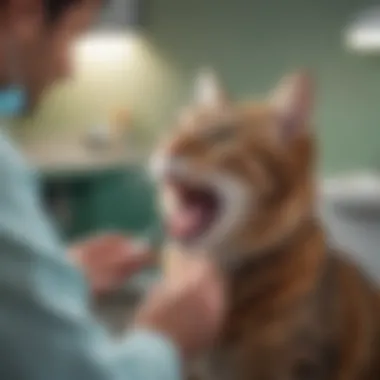Exploring Pet Insurance for Dental Care Options


Intro
Pet dental health is an often overlooked yet crucial aspect of overall well-being in pets. Many pet owners may not realize that dental issues can lead to serious health complications if left untreated. Therefore, understanding pet insurance options that encompass dental coverage is essential. This article explores the landscape of pet insurance, addressing common misconceptions, defining important terms, and reviewing various providers.
Coverage Options
Types of Coverage Available
When considering pet insurance for dental coverage, it is vital to know the types of coverage available. Policies can generally be broken down into two categories: accident-only coverage and comprehensive coverage.
- Accident-Only Coverage: This type covers injuries that occur due to accidents. While it may include some dental services related to accidents, it often does not cover routine dental care or preventative treatment.
- Comprehensive Coverage: This plan offers a broader range of coverage, including routine dental cleanings, extractions, and treatments for dental diseases. Most pet owners will find this type of coverage more beneficial in the long run.
Many providers have different plans tailored to specific breeds or conditions, so examining these details carefully is important.
Liability Coverage Explained
Liability coverage in pet insurance generally pertains to protection against claims resulting from your pet's actions. Although this may not directly relate to dental coverage, it’s still an essential aspect of insurance policies. If your pet injures another pet or person, liability protection can help cover costs associated with their injuries or damages. Always review the specifics regarding liabilities to understand how they integrate with your dental insurance needs.
Key Considerations
Factors to Assess When Choosing Insurance
Choosing the right pet insurance involves multiple factors that can significantly impact the coverage you receive. Here are key considerations to take into account:
- Pre-existing Conditions: Many insurers will not cover dental issues that existed prior to obtaining a policy.
- Age of the Pet: Insurance providers often adjust premiums based on the age of the pet, as older pets may be more prone to dental diseases.
- Coverage Limits: Knowing the annual and lifetime limits on claims will help you assess if a policy suits your financial situation.
Understanding Policy Limits
Each insurance policy comes with specific limits that cap the amount reimbursed for dental care. Understanding these limits is crucial for making informed decisions about coverage:
- Annual Limits: This refers to the total amount your insurer will pay for dental services within a year.
- Lifetime Limits: This is the maximum amount your pet insurance provider will pay throughout the life of your pet.
Ensure that the limits in the selected plan align with the potential dental care your pet may require. Taking time to read the fine print and understand the nuances can alleviate future financial stress and ensure your pet receives adequate care.
"Choosing the right pet insurance with dental coverage can safeguard your pet's health and save you from high out-of-pocket expenses later."
Understanding Pet Insurance
Pet insurance can be a crucial component of responsible pet ownership. It helps alleviate the financial burden of unexpected medical expenses. This section aims to clarify the fundamentals of pet insurance and its importance, especially regarding dental care. Understanding the nuances of pet insurance allows pet owners to make informed decisions tailored to their furry companions' needs.
What is Pet Insurance?
Pet insurance is a policy designed to cover a portion of veterinary expenses incurred while caring for pets. Policies can vary widely, but most include coverage for accidents, illnesses, and, increasingly, dental care. Pet owners typically pay a monthly premium and may also be responsible for co-payments or deductibles when filing a claim.
Policies can be customized based on the pet's age, breed, and pre-existing conditions. It is essential to read the fine print of any policy to understand what is covered and excluded. Some policies provide comprehensive coverage, while others might have limits, especially in areas like dental health. So, it’s vital for pet owners to choose a plan that aligns with their pet's health profile and lifestyle.
The Importance of Dental Care in Pets
Dental health is often overlooked by pet owners, yet it plays a significant role in their overall well-being. Just like humans, pets can suffer from dental diseases such as gingivitis or periodontal disease. These conditions can lead to pain, tooth loss, and more severe health issues if untreated.
Regular dental check-ups and cleanings are crucial. However, these procedures could be costly without insurance coverage. Furthermore, dental disease can potentially affect other organs, causing serious health issues. Thus, ensuring that a pet insurance plan covers dental care is a prudent part of maintaining a pet's health.
"Preventative dental care can save money and ensure a pet lives a longer, healthier life."
By understanding insurance offerings, pet owners can better navigate the uncertain waters of pet care expenses, ensuring they are never unprepared for their pets' dental needs.


Common Exclusions in Pet Insurance
In considering pet insurance, understanding common exclusions is vital for pet owners. Many policies, while offering attractive coverage, come with limitations that may not be immediately obvious. These exclusions can impact the affordability and efficacy of the insurance when dental issues arise.
Adhering to common exclusions can shield you from unexpected costs related to your pet's dental care. Awareness of what is not included helps in selecting a plan that suits your pet’s specific needs. It can assist in aligning your expectations with the policy's terms, thus ensuring that you are not caught off guard during a crisis.
Accidents versus Routine Care
Pet insurance normally differentiates between accident-related coverage and routine care. Routine care refers to general check-ups and preventive treatments, such as dental cleanings. Unless expressly stated, many plans do not cover routine dental care.
In contrast, accidents involve sudden injuries or events that require immediate treatment. If a pet suffers a dental emergency, such as a broken tooth due to a fall, insurance may cover treatments if the incident is classified as an accident. Pet owners need to read the terms carefully to see how the policy treats the different categories.
Evaluating Pre-existing Conditions
When applying for pet insurance, pre-existing conditions are a significant point of contention. Insurers often refuse to cover health issues that existed before the policy's inception. This exclusion applies to dental conditions as well. If your pet has previously been diagnosed with gum disease, for example, treatments associated with this problem may not be reimbursed.
Evaluation of pre-existing conditions requires pet owners to provide thorough medical histories. Some companies may offer limited coverage options for dental conditions that have stabilized. However, you must be cautious. If a dental problem recurs or worsens, the coverage may not extend to those future treatments.
Understanding these exclusions allows pet owners to make informed decisions about their insurance options. Knowing the nuances of accident coverage and pre-existing conditions can avert potential pitfalls.
By grasping the implications of these common exclusions, pet owners position themselves to better navigate their choices in pet insurance. This knowledge not only fosters a proactive approach to health management but also encourages a thoughtful selection process when considering plans for dental coverage.
Dental Coverage and Its Benefits
Dental coverage is a crucial aspect of pet insurance that often goes unnoticed by many pet owners. Understanding the benefits of having dental coverage can greatly influence a pet owner’s decision when selecting an insurance policy. Pets, like humans, require regular dental care to maintain oral health. Issues such as periodontal disease can lead to more severe health problems affecting not just oral health but the entire body.
Types of Dental Procedures Covered
When considering pet insurance, it is important to look closely at the various dental procedures that are typically covered. Here is a list of common procedures that many policies include:
- Routine Cleanings: Regular cleanings prevent plaque buildup and keep teeth healthy.
- Extractions: Sometimes, teeth need to be removed due to decay or damage.
- X-rays: Diagnostic imaging is often necessary to assess underlying dental issues.
- Treatment of Oral Diseases: This may include gingivitis and other gum diseases.
Coverage can vary significantly among insurance providers. Some plans might only cover a limited range of procedures or impose stringent conditions for coverage. Thus, pet owners should always read the fine print of their policy.
Impact of Dental Health on Overall Well-being
The importance of maintaining a pet’s dental health cannot be overstated. Poor dental hygiene not only leads to bad breath and discomfort but also has far-reaching implications for the overall health of the pet. Dental disease can contribute to serious conditions such as kidney disease, liver problems, and heart issues. The bacteria from infected gums can enter the bloodstream and affect vital organs.
Key Considerations:
- Regular dental check-ups can help detect issues early.
- Maintaining healthy gums can improve a pet's quality of life significantly.
- Pet owners should be proactive in seeking coverage that offers a comprehensive approach to dental care.
"Dental care is an essential part of a pet's overall health, and insurance that covers it can save lives and money in the long run."
Insurance Providers Offering Dental Coverage
Understanding which insurance providers offer dental coverage for pets is crucial for pet owners. This aspect of pet insurance can significantly impact how effectively a pet's dental health is maintained. The right insurance can help cover routine cleanings, screenings, and even more extensive dental procedures when necessary. Knowing your options enables owners to make educated choices that align with their pets' specific needs as well as their own financial situation.
Overview of Leading Insurance Companies
Several companies stand out in the market for their pet insurance offerings that include dental coverage. These providers vary in their policies, benefits, and cost structures.
- Nationwide: They offer a comprehensive plan that covers both accidents and routine dental care. Policies can be customized based on the pet's age and health status.
- Healthy Paws: This provider focuses on accident and illness coverage but includes dental coverage for specific dental procedures that result from underlying health issues.
- Embrace: Their policies cover many dental issues, including periodic cleanings. They offer a wellness plan that provides additional coverage for preventive care.
- Trupanion: Known for its high payout limits and lack of payout caps, Trupanion covers dental procedures that are part of a wider medical treatment plan.
Choosing among these providers requires evaluating each one's specific offerings and how they align with individual pet needs.
Comparison of Plans for Dental Coverage


When comparing plans for dental coverage, several elements should be taken into account.
- Coverage Scope: Some plans cover only major dental procedures like extractions, while others include routine care including teeth cleaning and preventative dental treatments.
- Waiting Periods: Most insurers impose waiting periods before benefits for dental coverage become effective. This can range from a few days to several months, depending on the provider.
- Maximum Benefits: Assessing the annual maximum coverage for dental care helps in understanding how much you would need to pay out of pocket. Some plans may have a higher maximum than others.
- Deductibles: Different deductible structures can alter the overall cost of accessing dental care. Owners should consider whether a lower premium with higher deductibles is a sustainable model.
Ultimately, a comparative analysis along these lines enables responsible financial planning while ensuring that dental care for pets is adequately addressed. This insight is particularly beneficial for pet owners who wish to ensure that their animals receive the best dental care possible without excessive out-of-pocket expenses.
Evaluating Coverage Limitations
Assessing the coverage limitations within pet insurance policies is a crucial step for pet owners seeking adequate dental protection. Understanding these limitations allows you to make informed choices, ensuring that you do not face unexpected costs or denied claims when your pet requires dental care. Key elements to consider include the annual maximums, deductibles, and waiting periods, all of which can significantly impact your overall experience with your chosen insurance plan.
Annual Maximums and Deductibles
Many pet insurance policies impose annual maximums, limiting the total coverage available for dental procedures within a year. For instance, if your plan has a maximum of $1,000, any dental expenses exceeding this amount will not be reimbursed. This feature is critical as it directly influences your financial risk. In many cases, a higher annual maximum can offer better protection, especially if your pet is prone to dental issues.
Deductibles, on the other hand, represent the amount you must pay out-of-pocket before your insurance coverage kicks in. For example, if your plan has a deductible of $300, you will need to pay that amount for dental procedures before claims can be made. It is essential to evaluate these figures in relation to your pet's health history. If your pet has had previous dental issues, a policy with lower deductibles and higher maximums may be more beneficial.
"Annual maximums and deductibles play a vital role in determining how much you will spend on dental care, underscoring the importance of understanding these elements before committing to an insurance plan."
Waiting Periods for Dental Benefits
Most insurance policies also have waiting periods, which is the time frame between when you purchase the insurance and when you can start receiving dental benefits. This can range from a few days to several months. Understanding this timeline is essential to avoid confusion when an immediate dental need arises.
During these waiting periods, any dental issues that may arise are typically not covered. Therefore, if your pet requires immediate dental care soon after obtaining insurance, you may find yourself responsible for the entire cost of the procedures.
Each provider may have different waiting periods for dental benefits. Consequently, it is advisable to read the fine print closely. You can also ask potential providers about their policies. This information can aid in choosing a plan that aligns with your expectations and your pet's health requirements.
In summary, analyzing coverage limitations such as annual maximums, deductibles, and waiting periods will empower pet owners. It helps them to navigate the complex landscape of pet dental insurance effectively.
Making an Informed Decision
Making an informed decision regarding pet insurance, especially for dental coverage, is crucial for every pet owner. This section delves into significant elements that contribute to a sound choice. Understanding your options not only ensures proper dental care for your pet but also helps to manage affordability in an intelligent way. Deductibles, coverage limits, and exclusions should all be clear before committing to any policy. It is also vital to recognize the specific needs of your pet, as this can influence the benefits you should prioritize.
Assessing Your Pet's Dental Needs
Every pet has unique dental needs based on their breed, age, and overall health. Conducting a thorough assessment of these needs can guide your choices effectively. Start by considering:
- Age: Older pets often require more frequent dental care. This includes routine cleanings and assessments. The likelihood of dental issues increases with age, making comprehensive coverage more important for senior pets.
- Breed Considerations: Certain breeds are predisposed to dental problems. For example, small breeds like Yorkshire Terriers may have dental overcrowding. Researching breed-specific dental issues can inform your insurance needs.
- Current Health Status: If your pet has pre-existing dental conditions, it is vital to understand how these may impact your coverage options. Some policies may not cover these existing issues, leading to higher out-of-pocket costs for treatments.
In summary, recognizing your pet’s specific dental needs aids in selecting a plan that optimally covers potential costs, ultimately allowing you better peace of mind.
Analyzing Financial Implications of Plans
Financial considerations are perhaps one of the most significant factors in deciding on pet insurance with dental coverage. Analyzing the financial implications involves understanding the following aspects:
- Premium Costs: The monthly or annual costs can vary between providers and the extent of coverage offered. It is essential to compare quotes and read the fine print to identify what you are paying for.
- Deductibles and Co-pays: Know how much you need to spend before the insurance kicks in. High deductibles may lessen premium costs but lead to larger out-of-pocket expenses during treatments. Additionally, some plans require co-pays for certain services.
- Lifetime Limits: Some plans feature lifetime maximums that cap coverage for claims within a year or over your pet's lifetime. Carefully assess these limits and factor them into your decision.
- Coverage Gaps: Understand what procedures may not be covered by the policy. Dental issues can include preventive care, extractions, and emergencies. Eligibility for these procedures needs to be understood clearly to avoid surprise costs.
"A well-informed decision not only secures your pet’s dental health but also safeguards your finances from unexpected costs."
By analyzing these financial elements, you can better align insurance plans with your budget and your pet's needs, ensuring that you make a comprehensive and thoughtful decision.
Common Misconceptions about Pet Dental Insurance
Understanding common misconceptions about pet dental insurance is vital for pet owners. This area often presents confusion that may hinder informed choices concerning a pet's dental health coverage. Knowledge about dental insurance specifics can shape the perception of what pet insurance actually offers.
Dental Care is Always Covered


A frequently held belief is that dental care is included in all pet insurance policies. However, this assumption can be misleading. Many insurance providers have specific exclusions related to dental care. Some may cover only particular procedures, leaving out essential services like routine cleanings or extractions.
Pet owners should carefully examine the policy documents or contact the insurance provider. Key details may include:
- Types of procedures covered: Most policies cover injuries or emergencies but may not extend to routine dental care.
- Waiting periods: Some plans impose a waiting period before dental benefits activate. It's important to be aware of this limitation to avoid surprises during a pet's dental emergency.
- Regional differences: Coverage can vary by location and veterinary practices, which is vital to consider during the analysis.
"Neglecting to verify coverage can lead to unexpected out-of-pocket costs."
In many cases, dental care services should not be assumed to be fully covered. Without confirmation, pet owners risk facing substantial expenses when seeking dental services for their pets.
All Policies Offer the Same Dental Benefits
Another misconception is that all pet insurance policies provide identical dental benefits. This is far from the reality as options vary significantly from one provider to another.
Critical factors that differentiate policies include:
- Coverage specifics: Some insurers may limit dental coverage only to accidents, while others include preventive care.
- Cost structures: Premiums, deductibles, and reimbursements can greatly differ across companies. Understanding these aspects will influence the long-term affordability of the plan.
- Provider networks: Selecting insurance tied to specific veterinarians or facilities can restrict acces to needed dental care.
By recognizing that insurance policies are not homogenous, pet owners can make better decisions aligned with their pets' needs. Reading the fine print and consulting with pet insurance specialists may offer further clarity when navigating options.
In summary, addressing these misconceptions mus be a priority. Clarity about what dental coverage entails allows for better preparation and management of a pet's dental health.
The Future of Pet Insurance Coverage
The landscape of pet insurance is evolving. As many pet owners become more aware of their pets' health needs, dental care has increasingly come to the forefront. Insurers are adjusting to these shifts. This section highlights future trends in the industry and the importance of understanding these changes. Exploring these trends offers hope for better and more inclusive coverage options.
Emerging Trends in Veterinary Care
Veterinary medicine is continuously advancing. New technologies and practices are making dental care for pets more effective. For instance, innovations in diagnostic imaging allow for earlier detection of oral diseases. As techniques become more sophisticated, treatment options expand. This is important because it leads to better health outcomes for pets.
Moreover, veterinarians are emphasizing preventive care. Policies that promote routine dental check-ups and cleanings can significantly improve dental health. Insurers are likely to respond by including more preventive measures within their plans. This is a beneficial shift for pet owners who want to provide optimal care for their animals. By aligning dental coverage with advancements in veterinary care, insurers can address the unique health needs of pets more effectively.
Shifts in Consumer Expectations
As awareness of pet health grows, pet owners are increasingly demanding comprehensive coverage. People are no longer satisfied with basic policies that exclude dental care. There is a greater expectation for transparency in what policies cover. Consumers want clarity on which dental procedures are included and how claims are processed.
There is also a rising preference for customizable insurance plans. Pet owners seek out options that allow them to tailor coverage to fit their specific needs. This means offering varied levels of dental coverage, depending on the age, breed, and health condition of their pets.
As more pet owners become well-informed, the insurance market will need to adapt. Those companies that listen and respond to these changing expectations will likely thrive.
"Consumer demands are shaping the future of pet insurance. Companies that meet these expectations will lead the market."
Ending
The conclusion of this article serves to underline the significance of pet insurance that includes dental coverage. As pet owners, understanding the nuances of dental health insurance can drastically influence the lifelong well-being of your pets. Many pet owners may overlook dental health, assuming it falls under general pet care. However, this article emphasizes that dental procedures often have distinct coverage terms under most insurance plans.
Having a clear grasp of what is covered, including routine cleanings and unexpected procedures, can save considerable amounts of money in the long run. This not only alleviates financial burden but also ensures that pets receive necessary dental care at the right time. Moreover, being aware of the limitations of policies regarding dental health is crucial.
As you reflect upon the insights provided, keep in mind your pet's unique needs and the importance of dental care as it relates to overall health. In a world where pets are considered family members, optimizing their dental health through appropriate insurance is a responsible choice for conscientious pet owners.
Recap of Key Points
To encapsulate the critical information shared throughout this article:
- Pet insurance serves as a protective measure against unexpected veterinary bills, particularly for dental procedures.
- It highlights the distinction between routine care and emergency services, emphasizing the importance of preventive care.
- Common exclusions can significantly affect coverage, particularly concerning pre-existing conditions and types of dental procedures offered.
- A variety of insurers exist, each with unique plans tailored for dental care, which necessitates close examination of policy details.
- Pet owners must assess their pets’ specific needs and consider how different plans align with those needs.
Final Considerations for Pet Owners
When it comes to pet dental insurance, there are several crucial aspects pet owners should consider before selecting a plan:
- Examine the Fine Print: Often, policies may appear promising at first glance but contain exclusions that could limit the benefits offered for dental care. Always read the details carefully.
- Talk to Your Veterinarian: Your veterinarian can provide guidance on the necessary dental procedures based on your pet’s health, helping you to make an informed decision.
- Compare Different Providers: Understand that coverage options vary between insurers. An insurance option that suits one pet might not fit another's needs.
- Factor Financial Implications: Consider not only the monthly premium but also potential out-of-pocket expenses, deductibles, and limits on annual claims.
In the end, informed decision-making around pet dental insurance can pave the way for healthier, happier pets. Evaluate each option and ensure your beloved animal receives the care it deserves.



